- "Banzai!"
-
"Banzai!" is a patriotic Japanese expression, also meaning "ferocious in an attack."
The Japanese used this battle cry during World War II to intimidate and distract Allied troops, similar to the Confederate Army's use of the famous "Rebel Yell" during the American Civil War.
- "Ten HUT!"
-
G.I.s during World War II were all too familiar with the order, "Ten hut," an abbreviation of "Attention!" Soldiers were required to snap-to, standing up straight, looking straight ahead, with arms pinned to their sides until given the order to stand "at ease."
Photograph: 34th WAC Post Headquarters Company, Fort Devens, Massachusetts, 1943. Minnesota Historical Society Photograph Collection. Loc. no. E448.25 p7
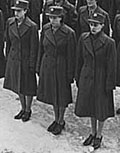
- Agricultural Adjustment Act (AAA)
-
To curb over-production of crops during the Great Depression and raise prices farmers would receive for their crops, Congress enacted the Agricultural Adjustment Act (AAA) (Public law 73-10) on May 12, 1933. Farmers agreed to reduce the number of acres cultivated and the number of livestock raised in exchange for subsidy payments from the federal government.
The AAA was unpopular for a number of reasons. To meet the terms of the agreements, many farmers were forced to stand by and watch as excess livestock was slaughtered to reduce herd size and crops already planted were destroyed. With thousands of people starving during the Great Depression, many Americans viewed this policy as wasteful.
Because the subsidies were paid through taxes on processors of farm products, the Supreme Court ruled the AAA unconstitutional in 1936.
In 1938 a second Agricultural Adjustment Act was passed, this time funded by the general tax pool. In spite of criticism, the AAA brought renewed hope to many farm families and provided a basis for farm policy for years to come.
- Ailerons
-
Ailerons are hinged wing flaps on aircraft that can be manipulated to make the airplane bank to one side or the other. The flaps always work in opposition to each other. For example, when the right aileron is flipped up and the left aileron is deflected downward, the plane will bank to the right.
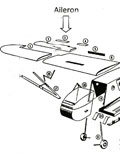
- Artillery
-
Artillery refers to large guns used on land, and to the field- and coastal-based troops responsible for their use. Field artillery weapons include Howitzers, mortars, anti-aircraft and anti-tank guns.
Photo: Unit of Battery H, 61st Coast Artillery, Minnesota National Guard demonstrates the Browning Anti-aircraft Machine Gun, Fort Snelling, 1940. Minnesota Historical Society Photograph Collection.
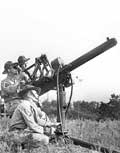
- Atabrine
-
American troops fighting in the South Pacific fell victim to the mosquito-borne illness, malaria, in large numbers. The best option for treatment during World War II was a synthetic drug, Atabrine, developed by a German doctor and introduced before the war.
In spite of the benefits, servicemen were reluctant to take the bitter pills, which turned the skin yellow and could cause headaches, nausea, and occasionally a temporary psychosis in patients.
- Baby Boom
-
The years immediately following World War II saw a trememdous spike in birth rates around the world, with an estmated 79 million babies born in the United States between 1946 and 1964. Known as the "Baby Boom", the rise in the birth rate reached its peak in 1957 when an estimated 123 of every 1,000 women aged 15 to 44 gave birth.
A flurry of school construction and expansions began as post-war babies reached school age. In the Twin Cities suburb of Bloomington, for example, sixteen schools were built between 1953 and 1963 to accommodate the influx of students into the school system, and in the village of St. Louis Park twelve schools were built and classrooms added to four existing schools between 1947 and 1963.
Photograph: Mothers and children, Buchanan Street Quonset Hut community, 1947. Photo courtesy Ed and Lee Sworsky.
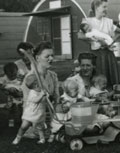
- Bang's Disease
-
Bang's disease, caused by Brucella abortus bacteria, affects cattle and other domestic and wild animal species. The disease is highly contagious and causes abortion, decreased milk production, and low fertility in cows. Because the disease is difficult to treat, farmers must remove infected animals from their herds to prevent the disease from spreading.
- Bivouac
-
A bivouac is a temporary military encampment consisting of tents or makeshift shelters.
- Black Tuesday
-
The economic prosperity of the 1920s ended abruptly with the stock market crash on "Black Thursday," October 24th, 1929. The following Tuesday, a panic ensued on Wall Street as investors frantically began selling off their investments. Black Tuesday, October 29, 1929 marked the beginning of the Great Depression in the United States.
- Blackout
-
The attack on Pearl Harbor led many Americans to fear the possibility of air raids on the mainland. The Office of Civilian Defense, organized in May 1941 trained volunteers across the country to conduct air raid drills to prepare the population for possible air attack. A blackout, extinguishing all artificial light outside homes and other structures, and placing "blackout curtains" across all openings to prevent interior lighting from being seen on the outside, was one measure taken to prevent enemy aircraft from spotting cities and other potential targets.
This 1942 photograph shows a Civilian Defense volunteer assisting a Minnesota couple with proper blackout precedures.
Photograph: Minneapolis Star Journal; Minnesota Historical Society Photograph Collections, 7/29/1942. Location number E448.14 p4

- Blitz
-
The term blitz is short for the German blitzkrieg, or "lightning war." This highly mobile form of warfare favored by Germany during World War II included swift yet massive surprise air attacks followed by tank and artillery fire.
- Bomber's Moon
-
"Bomber's Moon" is a term for a brightly moonlit night, allowing bomber crews to see targets clearly. Betty Magnuson Olson refers to the Bomber's Moon that shone on Christmas Eve, 1944, which helped turn the tide in the Battle of the Bulge. The German offensive was brought to a standstill that day, and the Allied forces began the advance toward Germany on Christmas Day.
- Bovine TB (Tuberculosis)
-
Bovine Tuberculosis is a chronic respiratory disease in cattle caused by the Mycobacterium bovis (M. bovis) bacteria. The disease, once common nationwide, was virtually eradicated in Minnesota until 2005, when new cases were reported in northwestern Minnesota. State legislation was passed in May 2008 to put a new plan in place to regain bovine TB-free status for the state.
- Brucellosis
-
Brucellosis is an infectious disease found in animals, caused by bacteria of the genus Brucella. The disease can be passed to humans that come into contact with an infected animal, or by ingesting contaminated milk or cheese, though cases in the United States are rare due to animal control measures. The disease in humans manifests in flu-like symptoms, and can in severe cases affect the central nervous system and heart.
- Canned
-
With money for necessities in short supply during the Great Depression, many families grew their own fruits and vegetables, and canned them at home to preserve them. Some meats were also canned.
In canning, foods are heated to destroy harmful microorganisms, then sealed under high pressure in air-tight glass jars.
Photo: Women preparing beans for canning, Hennepin County, 1938. MHS Photograph Collection, Location no. E445.1 r142.
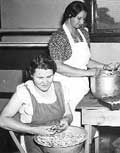
- Chaff
-
Chaff refers to the straw that remains after the grain has been threshed. This 1931 picture of the McQuire Brothers threshing rig shows large stacks of chaff. The threshing machine is blowing chaff onto the stack on the left, while the men in the center of the photo are catching the grain in large sacks.
Photo: McGuire Brothers threshing outfit, 9/19/1931. Photographer: John Runk (1878-1964), MHS Photograph Collection, Location no. Runk 2390.

- Chaplain
-
A military chaplain is a trained member of the clergy attached to a military unit. A chaplain provides spiritual and pastoral support for service personnel, including the conduct of religious services at sea or in the field. Many units had chaplains for both Christian and Jewish faiths.
A total of 8,896 chaplains served in the U.S. Army during World War II, earning 2,453 decorations. 77 chaplains were killed.
Photo: Field service: 45th "Thunderbird" Division, World War II. Source: U.S. Army Chaplain Center and School.
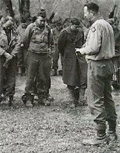
- Cistern
-
Before indoor plumbing, many homes had a hand-pump at the kitchen sink that was connected to a cistern, a man-made underground tank designed to catch and hold rainwater. Cisterns had to be waterproof, and typically had a protective cover to keep the water clean. Water for washing, bathing, and cooking had to be pumped by hand from the cistern or from an outdoor well and heated on a wood- or coal-burning stove, carried and poured into a washbasin or tub. Water for livestock and garden use was often pulled from an outdoor well, either by a hand-pump or by a windmill.
As farms gained access to electricity, families could employ electric pumps to bring water into their homes. Indoor bathrooms became more common. Water heaters made it possible to draw hot and cold water from indoor taps, making once-a-week baths with shared bathwater a thing of the past.
In 1930, only a small percentage of farm homes in Minnesota had indoor plumbing, and some rural families would wait until the 1950s to add this improvement.
Photo: Woman filling tea kettle from cistern pump in farm kitchen, 1910. MHS Photograph Collection, Location no. GT2.51 r1.
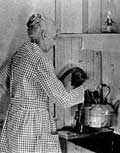
- Civilian Conservation Corps
-
The Civilian Conservation Corps (CCC) was established in 1933 as part of President Roosevelt's New Deal legislation to provide meaningful work for young men aged 17 to 23. Recruits signed up for a six-month term, and could enroll in two consecutive terms before moving on. They earned $30 per month, $25 of which had to be sent home to their families. The government furnished them with clothing, housing and food, and put them to work building dams, roads and firebreaks, constructing stone and log buildings in state and national parks, fighting forest fires, and assisting farmers with soil conservation measures.
By the time the program was disbanded in 1942 84,000 young Minnesota men had benefited from working in the CCC.
Photo: Civilian Conservation Corps fire fighters, northern Minnesota, ca. 1933. St. Paul Dispatch, MHS Photograph Collection, Location no. SC4.2 r17.

- Conscription
-
Conscription refers to required military service, commonly known in America as "the draft."
In the United States, wartime conscription began during World War I, instituted by the Selective Service Act of 1917.
The Selective Service Act of 1940, passed in response to the fall of France to Germany, initiated the first peacetime conscription in U.S. history as America prepared for the possibility of entry into World War II. The Act required all men aged 21 to 35 to register for the draft. A second Act passed after the U.S. entered the war required all men aged 18 to 65 to register, with those 18 to 45 eligible for military service.
- Contour Farming
-
Contour farming is a method of cultivating that follows the natural lay of the land, curving around hills, rather than plowing straight furrows up and down. This method creates ridges, which hold topsoil and seeds in place, helping to prevent water erosion of soil.
Photo: Contour plowing near Millville, Wabasha County, 1937. MHS Photograph Collection, Location no. SA4.2 r3.
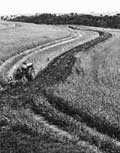
- Cryptographer
-
A cryptographer is a person who breaks coded language. Cryptographers were needed during World War II to decipher coded messages intercepted from Germany and Japan.
- Cystosomiasis
-
Cystosomiasis is a disease caused by contact with water infested with snail-borne parasitic worms that bore under the skin. Symptoms include a high fever.
- Distinguished Unit Citation
-
The Distinguished Unit Citation is awarded to Army or Air Force service units for meritorious service. Ken Fritz's Army Air Corps 1st Fighter Group received three citations for heroic service during World War II: Italy, 25 Aug 1943; Italy, 30 Aug 1943; Ploesti, Rumania, 18 May 1944.
- Emergency Conservation Work Act
-
The Emergency Conservation Work Act (Senate Bill No. 5.598) was signed into law on March 31, 1933. One of the first of President Franklin D. Roosevelt's "New Deal" programs, it created jobs for the unemployed and paved the way for the creation of the Civilian Conservation Corps.
- European Theater
-
The United States was involved on three different fronts in World War II: North Africa and Italy, Europe, and in the Pacific. Troops fighting in France, Belgium, the Netherlands, and Germany served in the European Theater of Operations, or "ETO".
- Farm Bureau
-
The Farm Bureau has been an important part of rural life in Minnesota since the first county Farm Bureau was set up in 1913. In 1919 twenty-four county Farm Bureaus organized the Minnesota Farm Bureau Federation, which in turn joined the American Farm Bureau Federation.
To a farmer, the Farm Bureau was a resource for information on modern farming methods on the local level, and a strong lobbying influence on State and National levels. Farm Bureau meetings were more than just meetings; they were opportunities for farm families to socialize.
Farm Bureaus across the state of Minnesota faced a crisis in the depression years as members found it difficult to pay their dues. Membership in the Minnesota Farm Bureau Federation dropped from 12,079 in 1931 to 5,215 in 1933, and then rebounded as the grip of the depression eased. Today the Minnesota Farm Bureau boasts 77 County Farm Bureaus with a total membership of more than 31,000.
The annual Farm Bureau picnic was a highlight for many, with interesting lectures, entertainment, and games for the whole family to enjoy.
Photo: Float decorated with produce in Farm Bureau picnic parade to promote farming in St. Louis County, 1930. MHS Photograph Collection, Location no. SA1.2 p15.
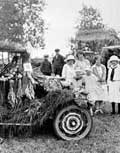
- Feed Shortage
-
The drought during the Great Depression made it difficult for farmers to grow sufficient grain and hay to feed their livestock, and meant shortages on the market for those needing to buy feed. Many farm animals faced starvation as farmers struggled to provide for them.
Photo: Starving cow and horse were brought by farmers to the State Capitol to dramatize their demands for relief, 1935. George E. Luxton, MHS Photograph Collection, Loc. No. SA5.2 p9.
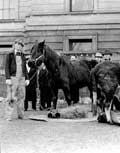
- Flak
-
Flak refers to the metal fragments from exploding shells fired by long-range anti-aircraft guns. The term derives from the German Flugabwehrkanone, or Flak, a type of aircraft defense cannon.
- Frisco Conference
-
The Frisco Conference refers to the United Nations Charter Conference, which was held in San Francisco from April 25 to June 26, 1945. The conference, coming at the close of World War II, was sponsored by the major Allied powers - the United States, Great Britain, China, and Russia - with delegates from 46 other countries participating. The goal of the conference was to approve a charter for an international peace-keeping entity in the hope that future global conflict might be avoided.
After just two months, the charter was approved and signed by 50 of the 51 original member nations (Poland, absent from the conference, signed later). Harold E. Stassen, former Governor of Minnesota (1939 to 1943), was chosen by President Roosevelt to be one of the 282 delegates to the U.N. Charter Conference, and was given the honor of signing for the United States. It took effect on October 24, 1945.
Photograph: Harold Stassen of Minnesota signing the United Nations charter, June 26, 1945. Minnesota Historical Society Photograph Collection, Loc. no. E450 p31.
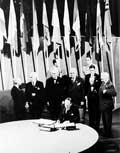
- Garrison
-
Garrison is the term for a body of troops stationed in a particular location - usually a city, town, or fort - to defend it. Today the term is sometimes used to refer to the location itself.
Minnesota's Third Infantry was the garrison stationed at Fort Snelling before and during World War II.
Photo: Troops at Fort Snelling, 1941. Photographer: Minneapolis Star Journal Tribune. Minnesota Historical Society Photograph Collection, Loc. no. MH5.9 F1.7 p129.
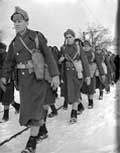
- Gas Rationing
-
When the United States entered World War II in 1941, the government began to channel food and other goods to the war effort. The need for supplies for the military meant shortages for Americans on the home front. To provide fair distribution of necessary items, the government implement a rationing system in 1942.
Transportation was affected by rationing in several ways. With a scarcity of metal and rubber, Americans found it difficult to buy a new car or replace the tires on an old one. Gasoline was also rationed, and a national speed limit of 35 miles per hour was imposed to save fuel and tires.
Civilians were issued one of a number of different classifications of gas cards, entitling them to different quantities of gasoline each week. A gas card and a ration book coupons had to be presented when purchasing fuel. Coupons were made valid for a set period, to prevent hoarding.
To get a classification and rationing stamps, one had to appear before a local board to certify a need for gas and ownership of no more than five tires. All tires in excess of five per driver were confiscated by the government, because of rubber shortages.
An A card was the lowest priority of gas rationing and entitled the holder to 3 to 4 gallons of gas per week. B cards were issued to workers in the military industry, entitling their holder up to 8 gallons of gas per week. C cards were granted to persons deemed very essential to the war effort, such as doctors. T rations were made available for truckers. Lastly, X cards entitled the holder to unlimited supplies and were the highest priority in the system. Ministers, police, volunteer firemen, and civil defense workers fell within this category.
Image: "I'll carry mine too!" Artist: Sarra, 1943. Minnesota Historical Society Poster Collection. Loc. no. E448.14 a44.
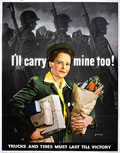
- GI Bill
-
The GI Bill, or Servicemen's Readjustment Act, passed by Congress in 1944, provided funds that enabled returning servicemen and women ("GIs") to attend college or vocational school, and offered low-interest loans for the purchase of a home or to start a business. The GI Bill helped many members of Minnesota's Greatest Generation realize dreams that wouldn't have been possible without it.
Millions took advantage of the program, flooding college campuses across the country and causing a boom in post-war construction. Photograph: Fathers in caps and gowns with their children, University Village, St. Paul, 1951. Minneapolis Star Journal Tribune; Minnesota Historical Society Photograph Collection.
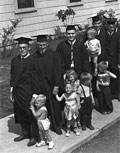
- Great Depression
-
The Great Depression was a worldwide economic crisis. In the United States, the depression was initiated by the stock market crash, and the investors' panic that followed, in October 1929. Banks closed their doors. Millions lost their jobs, their homes, and their self-esteem. Farmers faced severe drought and falling prices for commodities. Families were torn apart as breadwinners were forced to leave home in search of work, and older children, whom the family could no longer support, set out on their own.
Recovery began with the implementation of President Franklin D. Roosevelt's "New Deal" policies (1933-1937), which provided aid to millions of desperate Americans, and helped the country to slowly get back on its feet. In spite of improved conditions, effects of the Great Depression continued to be felt until the U.S. entered World War II, when millions of young men were called to serve in the military and wartime industry fueled the economy by creating jobs for civilians.
Many families found themselves living in difficult conditions. The woman in this photograph is shown heating water in an unheated, run-down shelter during the Great Depression, 1937.
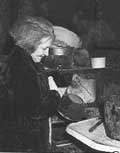
- Grenades
-
Grenades are small bombs with a delayed explosive action, commonly used by soldiers to reach the enemy in trench warfare. Different types of grenades may be either thrown by hand or shot from a weapon.
- Guernsey
-
Guernsey cows, a leading dairy breed, originated on the island the Guernsey in the English Channel. Guernseys are valued for their high quality milk that is rich in protein and butterfat.
Photo: American Grand Champion Guernsey cow, 1935. Hildebrand, MHS Photograph Collection, Loc. no. SA3.1 p25.

- Haole
-
Haole, (pronounced: How-leh) in the Hawaiian language, means "foreign" or "foreigner"; it can be used in reference to people, plants, and animals. Haole, in its current definition, first became associated with the children of Caucasian immigrant children in the early 1820s.
- Hide the Thimble
-
Simple games using found objects kept children entertained for hours during the Great Depression. One such game was "Hide the Thimble," which could be played with an ordinary sewing thimble, like the one pictured here. Other objects could be substituted, such as a wooden thread spool or button.
To play the game, one person hides the thimble while the others cover their eyes. The other players then look for the thimble, with or without clues such as "You're getting warmer" or "You're getting colder." When spotted, the finder cries out "I spy!" and hides the thimble for the next round.
Object: Thimble, metal, 1920-1940, created by Strandquist Mercantile Company. MHS 3D Objects Collection, ID: 1987.217.5.

- Incendiaries
-
Incendiaries, also known as fire bombs, are bombs containing flammable chemicals that are intended to cause a fire upon impact. These weapons were used by both Allied and Axis powers during World War II.
A large bomb casing was filled with small sticks of incendiaries (bomblets). It was designed to open in the air, scattering the bomblets in order to cover a wide area. An explosive charge would then ignite the incendiary material. The fire burns at extreme temperatures that could destroy most buildings made of wood or other combustible materials.
Originally, incendiaries were developed in order to destroy the many small, decentralized war industries located (often intentionally) throughout vast tracts of city acreage in an effort to escape destruction by conventionally-aimed high-explosive bombs.
- Issei, Nisei, Kibei, and Sansei
-
When it was determined by the U.S. government that persons of Japanese descent might constitute a threat to national security during World War II, President Roosevelt followed the recommendation of his advisors and signed Executive Order 9066, giving the Secretary of War the power to determine "military areas" and to evacuate "any and all persons" from such areas. By this order, the government could effectively remove all Japanese-Americans from the Pacific coast and send them to relocation centers for eventual resettlement elsewhere.
The Japanese-Americans were classified into four groups:
1. Issei - 1st generation Japanese immigrants who by the law at the time were denied U.S. citizenship.
2. Nisei - the children of the Issei, second-generation Japanese-Americans who were citizens by birth and who were educated in the U.S.
3. Kibei - those who were American born, but who were educated in Japan.
4. Sansei - third-generation Japanese-Americans, children of the Nisei.The internment affected some 116,500 people. Many families that were resettled to other parts of the country during the war chose to remain there after the war.
- Jitterbug
-
The swing dance craze of the 1930s and 1940s began at the Savoy ballroom in New York’s Harlem with the "Lindy Hop," and became a world-wide sensation known as the Jitterbug. Inspired by both African and European dance traditions, the jitterbug is a lively combination of partner and whole-body movement dance. Ballrooms sprang up across the country where young people could dance to the sounds of big bands.
Photo: Dancers watch as black couples dance the jitterbug, Harvest Moon ball, St. Paul Auditorium, 1945. St. Paul Dispatch & Pioneer Press, MHS Photograph Collection, Location no. GV1.3 m3.
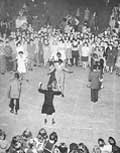
- Long Blader
-
A long blader is a skater who wears skates with longer blades than those found on hockey or figure skates. This type of skate is typically used for speed skating.
Photo: Speed skating contest at Powderhorn Park, Minneapolis, 1935. MHS Photograph Collection, Location no. GV3.72 p21.
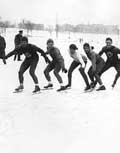
- Mess
-
Military personnel eat communal meals in the mess, or mess hall. In her letter home, Anne Bosanko Green mentions "Time out for mess" when she takes a break from writing to go to the mess hall for dinner.
- Micrometer
-
A micrometer is an instrument used for measuring very small distances, angles and objects.
- NAACP
-
The NAACP, or National Association for the Advancement of Colored People, was founded in 1909 in response to race riots in Springfield, Illinois by William English Walling, Mary White Ovington, Dr. Henry Moskowitz, Ida Wells-Barnett, W.E.B. DuBois, and Oswald Garrison Villiard. For nearly a century the organization has organized protests and has taken on legal battles on behalf of victims of racial injustice.
Perhaps the best known member of the NAACP from Minnesota was Roy Wilkins (1909-1981), who began his work for civil rights in St. Paul. Mr. Wilkins served as editor for the NAACP journal, The Crisis and was made Chairman of the national organization in 1955. In that capacity, he worked for the passage of the 1964 Civil Rights Act, the 1965 Voting Rights Act, and the 1968 Fair Housing Act.
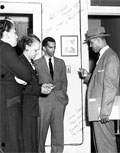
- National Child Labor Committee
-
The National Child Labor Committee (NCLC) was established in 1904 and chartered by an Act of Congress in 1907. Believing that children belonged in school and not at work, the NCLC promoted an end to child labor in the United States and worked for compulsory education in all states. A milestone in child labor reform was reached in 1912 when a Children's Bureau was organized in both the U.S. Department of Commerce and Department of Labor.
After the Supreme Court ruled a ban on child labor unconstitutional, the NCLC turned its attention to a constitutional amendment to ban child labor. In 1938, the Fair Labor Standards Act was passed, which contained more stringent regulations for the employment of children.
The NCLC is still actively involved in protecting young workers in the United States today.
Photo: Children studying at their desks in classroom in Jackson School, Minneapolis, 1925. MHS Photograph Collection, Location no. L3.2 r10.
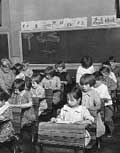
- National Industrial Recovery Act
-
The National Industrial Recovery Act (NIRA), passed on June 16, 1933, was intended to stimulate the struggling U.S. economy.
As part of President Franklin D. Roosevelt's "New Deal," the NIRA (under the auspices of the National Recovery Administration) was designed to promote fair competition by creating jobs, capping prices on some commodities, setting a minimum wage, limiting the hours worked per week, and tightening restrictions on child labor.
These laws were difficult to enforce and were criticized for allowing industry too much control in setting their own codes. In 1935, the NIRA was ruled unconstitutional by unanimous vote of the U.S. Supreme Court. The court determined that excessive power had been granted to the president, and cited an infringement on states' rights in interstate commerce by Congress.
Photo: National Recovery Administration's emblem displayed in flowers by Holm and Olson at the State Fair, 1933. MHS Photograph Collection, Location no. E445 p25.
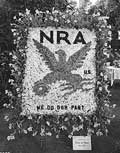
- Nazi
-
A Nazi was a member of the National Socialist German Workers Party, a political party led by Adolf Hitler that was active in Germany from 1920 to 1945. The fundamental Nazi belief in the racial purity of the German people resulted in the persecution, imprisonment and mass murder of those they believed to be "defective," including Jews, Slavs, religious leaders, mentally and physically disabled persons, and communists.
Image: The Nazis were portrayed in American wartime propaganda as pure evil, as this poster depicts. "This is the Enemy," 1943. MHS Poster Collection, Loc. no. E448.19 a27.
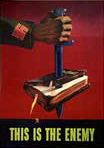
- New Deal
-
At the height of the depression (1933-1937) President Franklin D. Roosevelt, aided by Congress, created a series of new government programs aimed at giving direct relief to millions of people most affected by financial hardship. The programs, known as the New Deal, helped our country to recover from crippling economic disaster, and reformed government policy to protect the country from similar problems in the future.
Many Minnesotans benefited from the "alphabet agencies" created as part of the New Deal. For example, the FERA (Federal Emergency Relief Administration) distributed $300,000,000 in relief to the poor nationwide in its first two years of operation; the AAA (Agricultural Adjustment Administration) provided price supports for farmers through crop and livestock reduction programs; the CCC (Civilian Conservation Corps) gave meaningful work to millions of young men across the country; and the REA (Rural Electrification Administration) brought electricity and telephone service to rural areas.
While many New Deal programs were eliminated before the end of World War II, it left a lasting legacy in the Federal Deposit Insurance Corporation, established in 1933 to guarantee bank accounts; the Securities and Exchange Commission (SEC), created in 1934 to regulate the buying and selling of stocks and other securities; and Social Security, a program started in 1935 that was funded through payroll tax to insure workers against unemployment, illness, disability, or death.
Photo: Workers on State Emergency Relief Administration farm near Duluth, 1935, which had been set up under the New Deal. MHS Photograph Collection, Location no. E445 r1.
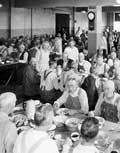
- Non-Com
-
A Non-Com, NCO, or Non-Commissioned Officer, is an enlisted member of the military who holds authority conferred by a commissioned officer.
In the United States Army, United States Air Force and United States Marine Corps, non-commissioned status includes all ranks of Sergeant. In the Marine Corps the rank of Corporal is also NCO. The rank of Corporal (E-4) in the Army is classified a junior NCO, and is shown the same respect as an NCO. In the U.S. Navy and U.S. Coast Guard, all ranks of Petty Officer are considered non-commissioned officers.
- Oak Leaf Cluster
-
The bronze oak leaf cluster is a small metal pin in the shape of oak leaves and acorns that is attached to a military ribbon decoration. The oak leaf cluster is awarded when the same decoration has been earned a second or more times. A silver oak leaf cluster may be worn in place of five bronze oak leaf clusters.
- Patriotism
-
Patriotism, being true to one's country, became a hallmark of Minnesota's Greatest Generation. Loyalty to the United States and respect for her flag were instilled at an early age through education.
The Little Citizens League was organized in the wake of World War I to help rural students "become well informed citizens, strong in body and habitually active in the service of their fellow beings, state and nation." The organization was revived in the mid-1920s as the Young Citizens League to provide citizenship training through rural schools, with emphasis on respect for government, public property, home, school, church, community, and on self-respect.
The dedication of League members is reflected in these lines from the "Young Citizens League March":
We march and sing; our voices ring;
Young citizens are we
Leagued in a host whose watchwords are
Youth, Courage, Loyalty
Hailing our nation's banner afloat in the sunlit sky;
Which through hopes and fears through future years,
We will hold ever more on high.
~Author UnknownPhoto: Children in patriotic costume planting a tree, 1923. MHS Photograph Collection, Location no. SC3.2 r6.
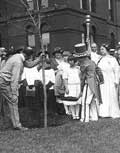
- Pearl Harbor
-
While most Americans were aware of the storm clouds over Europe, the country was taken completely by surprise when the Japanese attacked the Hawaiian military base at Pearl Harbor on Sunday, December 7, 1941. Many people had no idea where Pearl Harbor was located.
Folks across the country tuned into their radios later that morning to hear that President Roosevelt had declared war on Japan. That day would become, as Roosevelt predicted, "the day that will live in infamy."
Throughout the war, "Remember Pearl Harbor!" served as the rallying cry that helped bring Americans together in a common cause. Photograph: USS Arizona burning after the Japanese attack on Pearl Harbor, December 7, 1941. Department of the Navy, National Archives and Records Administration.

- Pinsetter
-
Before the days of automatic equipment to reset bowling pins, bowling alleys employed children to sit behind the pins to clear those knocked down, and reset them by hand. It was a perilous job; a pinsetter could be hit by flying pins or an errant bowling ball.
The first automatic pinsetters were introduced by the Brunswick Company in 1956.
Photo: Pinsetters at work at Midway alleys, 1937. MHS Photograph Collection, Location no. GV3.16 p5.
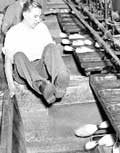
- Plasma
-
Plasma is the yellowish liquid found in the blood in which blood cells are suspended.
- Points
-
The end of the war meant "going home" to thousands of American servicemen and women. For most, discharge was delayed due to the implementation of the Adjusted Service Rating (ASR) Score, a point system implemented at the end of hostilities in Europe.
To return to the US, enlisted men had to have an ASR of 85 points, and enlisted women, 44 points. One point was awarded for each month in the service, with an additional point for each month served abroad. Five points were earned for each campaign star earned, and for each award received (such as a Silver Star, Purple Heart, etc.). An additional 12 points per child was awarded to those with children under age 18. All servicewomen married to veterans were automatically eligible for discharge by late May 1945. Those with fewer than the necessary points were retained for occupation duty or possible reassignment to the Pacific Theater of Operations, pending an invasion of the home island of Japan.
The total points needed for discharge was revised to 75 for enlisted men and 37 for women shortly after the surrender of Japan, when fewer military personnel were needed.
- Poor Country Roads
-
Until the mid-1930s country roads were few and of poor quality, making transportation difficult. With the advent of the Works Progress Administration (1935), better "farm-to-market" roads began to crisscross the state, making it easier for farmers to get their crops and livestock to market, and for their children to get to school.
Photo: Mucker and truck at work on the farm to market road being constructed by Works Progress Administration, 1936. MHS Photograph Collection, Location no. HE3.81 r65.
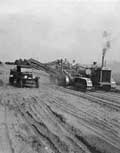
- Privy, Slop Jar
-
Many rural Minnesotans did not have indoor plumbing during the 1920s and 1930s. Instead, a mad dash to the privy, or outhouse, outside was necessary when answering nature's call. In the winter, families often used slop jars or chamber pots, a covered jar or bucket tucked under the bed as a substitute for a toilet. The disagreeable task of emptying the slop jars was just as necessary each morning.
Object: Slop jar, glass, ca. 1901-1920. Creator: FJE, Nankin(?), MHS 3-D Objects Collection, ID: 1988.156.214.1.A,B.

- Pulp Logs
-
Pulp logs are low quality trees harvested for the purpose of papermaking. The wood is reduced to a soft mass by removing the bark, and grinders, heat and pressure, or chemicals are used to separate the fibers, depending upon the quality of pulp desired. The pulp is bleached if intended for white paper products.
Softwoods, such as pine and spruce trees, and hardwoods like birch and maple, are used for making pulp.
Photo: The men in this photograph are loading pulpwood for the International Lumber company in northern Minnesota, 1935. Napolean N. Nadeau, State Archives Collection, Minnesota Historical Society.
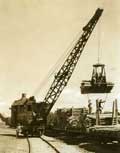
- PWA (Public Works Administration)
-
The P.W.A. (Public Works Administration), a New Deal agency, was created by the National Recovery Act of 1933 to contract with private businesses for the construction of public works to create jobs and stimulate economic growth. Projects included roads, schools, hospitals, bridges, and dams to fuel hydroelectric plants, funded with a total of $6 billion, allocated over six years, from 1933 to 1939.
- PX
-
PX on an Army base stands for "Post Exchange," a department-type store where soldiers can purchase whatever consumer goods they might need, such as clothing, toiletry items, candy, books, and other articles. For those serving overseas in World War II, the PX was the one place that servicemen and women could find American merchandise.
- Quonset Hut
-
The Quonset hut, was developed during World War II when the Navy needed a portable building that could be assembled by unskilled labor.
Prefabricated of corrugated steel with plywood ends, the huts were shaped like a cylinder cut in half lengthwise. They were insulated and had a wood floor. The undivided interior of the huts made them suitable for use as barracks, offices, housing, and hospital wards. Quonset huts came in various sizes ranging from 16'x36' to 40'x100' models used as warehouses.
More than 150,000 Quonset huts were produced during the war. Surplus huts were made available to the public for $1,000 each. A large number of them were put into service after the war as temporary housing. The Twin Cities had Quonset hut communities located on Buchanan Street in Northeast Minneapolis, Belvidere Park in West St. Paul, and at 27th Street and Como Avenue near the University of Minnesota.
Photograph: Aerial view of University Village for G.I. housing at Twenty Seventh Street and Como Avenue, Minneapolis, 1946. Minnesota Historical Society Photograph Collection. Location no. FM6.818 p2
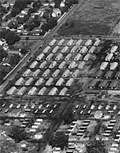
- Railroad Island
-
The Railroad Island neighborhood of St. Paul was so called because it was surrounded by railroad tracks, forming a triangular shaped area. Tracks from the Great Northern, Northern Pacific, and Soo Line railroads provided boundaries for this traditionally immigrant neighborhood, which encompassed the old Swede Hollow area of the city. With the coming of Interstate 94, Railroad Island all but disappeared.
- Record Unemployment
-
In the darkest days of the Depression (1933), the United States experienced record unemployment, when 12,830,000 able-bodied American workers were without jobs, or 25% of the country's workforce. In Minnesota, 29% of the state's 1 million workers were unemployed. On Minnesota's Iron Range unemployment reached a whopping 70%.
To put this into perspective, the average national unemployment rate for 2005 was 5.1%.
Mass unemployment meant that many families lost their homes or abandoned drought-ridden farms; others were split up as adults left home to look for work. Unemployed youth became a burden on their families and took to riding the rails in search of work, joining the ranks of the hobos.
Photo: unemployed men sleeping and sitting in Gateway Park, Minneapolis, 1933. MHS Photograph Collection, Location no. E440 p11.

- Roaring Twenties
-
The 1920s put the "decade" in "decadence." It was a time of radical change that inspired the nickname, the Roaring Twenties.
In the years following World War I Americans were hungry for everything new. In the glow of a strong economy, they embraced new technology in the form of new cars and electric appliances. They danced the "Charleston," tangoed to sensational new jazz music, and attended the first "talking" motion pictures. They read the likes of Sinclair Lewis and F. Scott Fitzgerald, and followed their favorite sports figures. Prohibition of alcohol led to a proliferation of "speakeasies" (establishments where illegal alcohol was served) and contributed to the rise of organized crime. Women gained the right to vote, and reveled in their new independence by bobbing their hair, shortening their hemlines, and abandoning 19th century social mores.
Photo: Contestants in the national championship marathon at the St. Paul Auditorium, 1929. MHS Photograph Collection, Location no. GV1.3 p66.
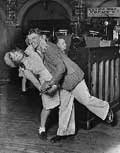
- Rural Electrification Administration (REA)
-
The Rural Electrification Administration (REA) was established by executive order of President Franklin Delano Roosevelt in 1935. The goal of the REA was to bring electricity and telephone service to rural areas. The REA helped to set up farmer-owned electric cooperatives. Money from government loans and raised by selling shares in the co-op and paid for the supplies and labor to raise poles and string lines.
Electric service allowed rural families to enjoy many of the labor-saving conveniences that town dwellers had enjoyed for a decade or more, and diminished the feeling of isolation through improved telephone service and electric-powered radio.
In 1930, less than 13 per cent of all farm families in Minnesota had electricity. By 1939 that number had grown to more than 30% per cent.
Photo: REA line crew, somewhere along the Iron Range, 1930s. MHS Photograph Collection, Location no. HD1.2 r2.
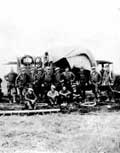
- Scrap Drives
-
Scrap Drives were held throughout the war years in an effort to obtain needed materials for the war effort. Children and adults alike participated in drives to collect paper for munitions, metals for the manufacture of tanks, ships and artillery, and rubber for tires, life rafts and gas masks. Housewives were encouraged to collect cooking fats and turn them in to their butcher for use in making explosives.
Photo: Get in the scrap. . .and help open the Second Front! Minnesota Historical Society Poster Collection, 1942. Loc. no. E448.14 a1.
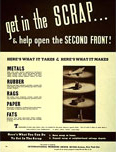
- Seaman
-
Women enlisting in the WAVES during World War II initially held the rate (not rank, which term is reserved for officers) of Seaman 3rd Class. Irene Levin, who served in the WAVES from 1944 to 1945, achieved the rate of Seaman 1st Class before recieving training to move up to Yeoman 3rd Class, the next level.
- Small Grains
-
Threshing crews helped with the harvest of such small grains as wheat, oats, rye, and barley.
Photo: Boy with prize-winning wheat, 1926. Paul W. Hamilton, MHS Photograph Collection, Location no. FM6.55H p39.
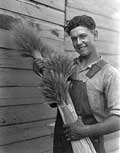
- Smith-Lever Act
-
The Smith-Lever Act is a federal law passed in 1914 that created cooperative extension services in connection with land-grant universities - those that received federal lands for the purpose of teaching agriculture and other subjects. The cooperative extension service, under the U.S. Department of Agriculture, administers funds to county extension services, which include agricultural, home demonstration, and 4-H programs.
- Social Security
-
The Social Security Act of 1935 provided economic security to an American population hit hard by the Great Depression by providing "a measure of protection" against job loss and economic hardship in old age.
President Franklin D. Roosevelt created by Executive Order the Committee on Economic Security on June 8, 1934 to study the problem of economic insecurity and make recommendations to Congress. The Committee made its report the following January, and after debate the bill passed and was signed into law on August 14, 1935.
The Act provided for both Grants to States for Old-Age Assistance and Federal Old-Age Benefits. It is the latter that forms the basis for our present Social Security program. The payroll tax began in 1937, and monthly benefits began in 1940.
- Soil Conservation Service
-
The Soil Conservation Service (SCS) was established by Congress on April 27, 1935 in response to the dire circumstances of the Dust Bowl. Extended drought conditions throughout the southern and midwestern plains states during the 1930s left fields subject to severe wind erosion. The SCS, a part of the Department of Agriculture, began to promote good soil conservation measures such as strip cropping and planting trees as windbreaks to help control erosion.
- SS Troops
-
The Schutzstaffel (German for "Protective Squadron", or "S.S.", was a paramilitary unit established by Hitler as his "Praetorian Guard." It was comprised of nearly one million soldiers known for their loyalty to the Nazi Party and the Führer. The SS troops were largely responsible for the worst of the Nazi war crimes committed by the Nazis during World War II.
- Stars and Stripes
-
Stars and Stripes, a newspaper for those in military service, began publication for the benefit of Union troops during the Civil War. It was brought back during both World Wars, and has been published continuously since 1942 in Europe, and since 1945 in the Pacific.
Produced by soldiers for their compatriots, no military control was ever exerted over the content of the newspaper, a caveat that was protected by such wartime illuminaries as General John J. Pershing and General Dwight D. Eisenhower.
The newspaper was produced as close to the front lines as possible, always moving with the troops. During World War II Stars and Stripes produced as many as 32 separate editions for servicemen and women around the world, and circulation reached 1 million copies - a testiment to the newspaper's popularity.
- Strafe
-
Strafe refers to machine gun fire from a low-flying aircraft.
- Strip Farming
-
Farmers could prevent water erosion of soil by strip farming (or strip cropping). Rows of wheat, corn, or other crop were planted in strips alternating with rows of a dense-rooted grass, such as alfalfa. The rows helped to stop water run-off and keep the soil in place. This method of planting was often combined with contour plowing, plowing furrows that follow the natural contours of the land.
Photo: Contour strip cropping on Earl Anderson farm, Lincoln County, 1964. G.A. Simpson, MHS Photograph Collections, Location no. SA2.4 p1.
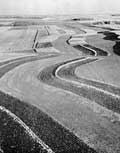
- Sulfa, Sulfanilamide
-
Sulfa drugs (or Sulfanilamide), refer to the first antibacterial drugs made from organic chemical compounds with antimicrobal properties. The first sulfa drug was Prontosil, developed in the 1930s by German scientists working for Bayer Corporation.
Prontosil was the first medicine that could effectively treat a range of bacterial infections inside the body. It had a strong protective action against infections caused by streptococci, including blood infections. This made sulfa drugs invaluable to medics treating wounded servicemen in World War II.
- U-Boats
-
German submarines were known as U-boats, an anglicized abbreviation for the German word "unterseeboot," or "undersea boat." The fleet consisted of more than 1,000 U-boats, and was charged with cutting off supplies to Great Britain in an attempt to force that country out of the war in Europe.
The greatest casualties of the U-boats were British and American merchant ships traveling in convoys to move troops, as well as bring food, fuel and other supplies to war-torn allied nations. This constant battle, known as the "Battle of the Atlantic," claimed at least 1,554 U.S. merchant ships, and the lives of approximately 9,500 U.S. Merchant Marine seamen.
Photo: German submarine U-3008, Type XXI, taken over by the US Navy after 1945 for use as a test vessel. Department of Navy, Navy Historical Center, 1948, public domain photograph; Wikipedia.org.
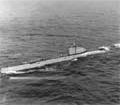
- V-J Day
-
V-J Day stands for "Victory over Japan Day." It commemorates the August 14, 1945 surrender of Japanese forces and the end of World War II. On that day, people across America took to the streets in spontaneous celebrations of the peace, while others knelt in prayerful thanks in nearby churches.
Those that may have missed the celebration had a second chance. President Harry S. Truman declared September 2, 1945 as the "official" V-J Day to coincide with the formal surrender ceremony that took place aboard the U.S.S. Missouri in Tokyo Bay on that date.
Photograph: VJ Day crowd celebrating in downtown Minneapolis, September 2, 1945. Minnesota Historical Society Photograph Collection, Loc. no. E448.17 r15.

- V-Mail
-
V-Mail was a solution to the problem of carrying mass quantities of mail to and from U.S. troops stationed abroad. Letters were written on a special V-Mail form, then photographed onto microfilm. The film was flown to a receiving station where it would be developed, and the letter, reduced to about 1/4 the original size, was printed out on photographic paper and delivered to the recipient.
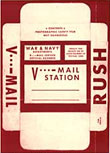
- Valedictorian
-
Valedictorian is an anglicized derivation from the Latin vale dicere, "to say farewell." The honor of serving as Valedictorian may be an appointment, won by popular vote, or awarded to the top student of the graduating class depending upon grade point average, extracurricular activities, and a vote of the class.
The valedictory address is an oration delivered at a the close of a high school or college graduation ceremony. The speech is meant to inspire, as well as offer thanks and farewell to the school on behalf of the class.
Photograph: Charles M. "Stubbie" Pearson gives the valedictory address at the Dartmouth commencement ceremony, May 10, 1942. Curtis Pearson, used with permission.

- Victory Gardens
-
Food shortages during World War II ignited a campaign to encourage Americans to grow their own foods, particularly vegetables and fruit, in backyard Victory Gardens. About 20 million Victory Gardens were planted across America, and supplied nearly 40% of all produce consumed in the United States during the war.
Photograph: Victory Garden, Dawson, MN, 1940-1949. Minnesota Historical Society Photograph Collection, Location no. E448.14 r12.
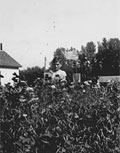
- War Bond
-
The Federal Government began to market Series E Savings Bonds on May 1, 1941 as "defense" bonds in an effort to raise money in anticipation of America's entrance in World War II. Later known as War Bonds, Americans were encouraged to purchase bonds as a patriotic duty. By the end of the war, more than 85,000,000 Americans had invested in war bonds.
Image: "Don't Let That Shadow Touch Them; Buy War Bonds." Artist: Lawrence Smith, Minnesota Historical Society Poster Collection, 1942. Loc. no. E448.11 a6
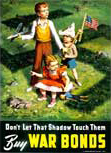
- War Manpower Commission
-
The War Manpower Commission was created on April 18, 1942 by Executive Order of President Roosevelt to formulate policies concerning the labor shortage precipitated by the large number of young men entering military service during World War II. The Commission was chaired by the Federal Security Administrator, and included representatives from the War Department, War Production Board, Federal Security Agency, the Civil Service Commission, the Departments of Agriculture, Labor, and the Navy and, for a time, the Selective Service System (draft).
The War Manpower Commission was abolished by Executive Order no. 9617, September 19, 1945.
Image: Women in the war - We Can't Win Without Them. War Manpower Commission, 1942. Minnesota Historical Society Poster Collection, Location no. E448.19 b43.
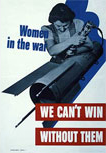
- Welfare
-
Welfare programs are social services designed to provide financial assistance to the needy. Before the Great Depression and President Franklin D. Roosevelt's New Deal, aid to the poor was largely in the hands of women's volunteer service organizations. By the mid-1930s, the Government began to take a substantial, active role in providing assistance to families hardest hit by the depression.
Photo: People lined up outside Food Stamp Office, 306 Fifth Avenue South, Minneapolis, 1940. Minneapolis Star Journal, MHS Photograph Collection, Location no. HV1.5 p2.

- WPA - Works Progress Administration
-
The WPA (Works Progress Administration) was one of President Roosevelt's New Deal programs to put millions of unemployed Americans back to work during the Great Depression. Authorized in April 1935, the program created both blue-collar and white-collar jobs on public projects, and generated work for artists and writers. Projects included the construction of public buildings, parks and roadways, and arts and literacy programs.
From 1935 to 1943, the WPA created nearly 8 million jobs, and cost the government nearly $7 billion. The program was discontinued in 1943 with the economic recovery stimulated by the war defense industry.
Photo: Picking beans, Works Progress Administation gardening at Morris. Minnesota Historical Society Photograph Collection, loc. no. SA4.59 r34.
- Yeoman
-
The United States Navy first began recruiting women during World War I. In 1942, the Navy again turned to women to help fill its stateside ranks. Most women enlistees initially held the rate (not rank, a term reserved for Navy officers) of Seaman 3rd Class. Those attaining the rate of Seaman 1st Class could qualify for Yeoman training. Navy WAVES who were rated as Yeomen were primarily assigned clerical responsibilities. Some WAVES Yeomen also assisted with translation, recruiting, and other activities.
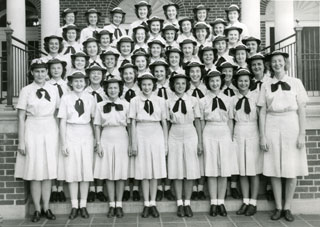
MNHS openings and announcements. More details.
- Membership |
- Shop |
- Calendar |
- Donate


